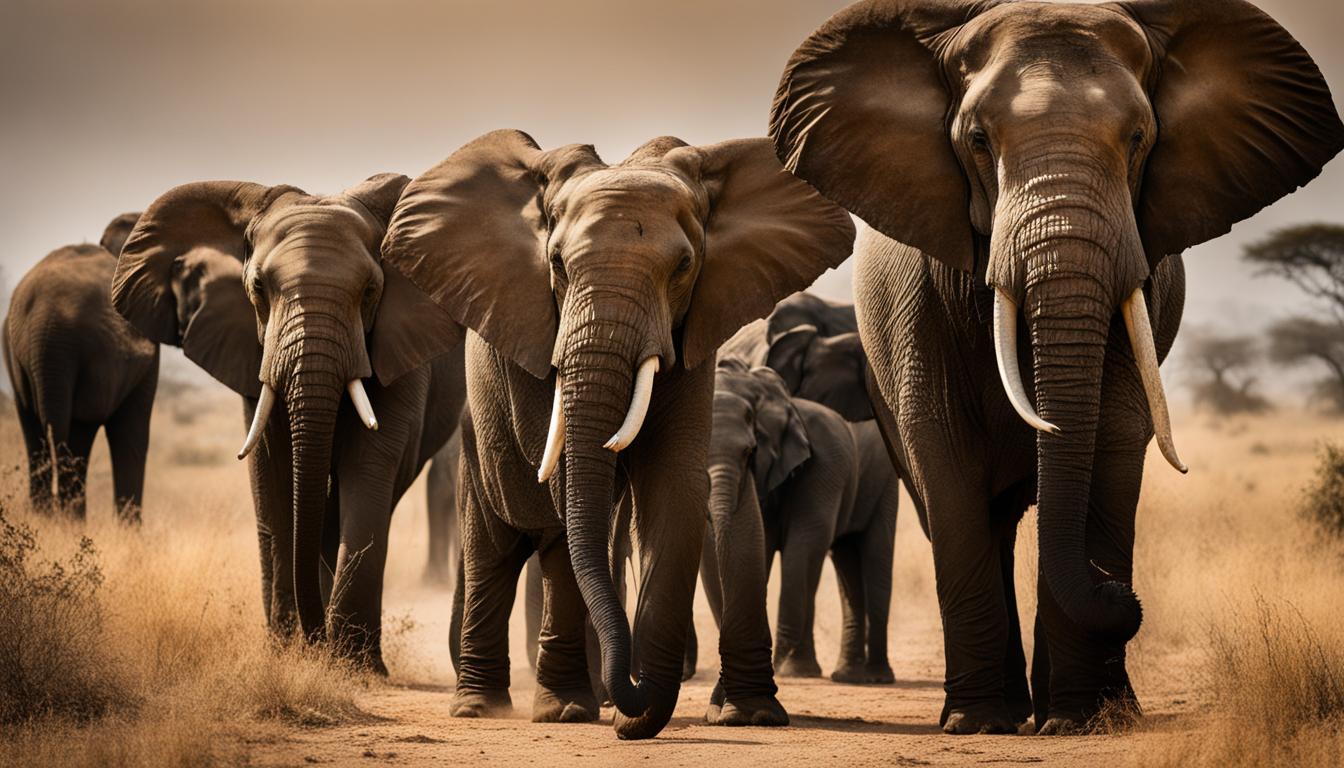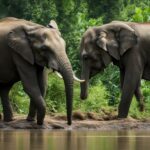Elephant family dynamics, social hierarchy in elephants, and elephant group behavior are fascinating aspects of these magnificent mammals. In this article, we will explore the various roles that different family members play in an elephant herd, shedding light on the intricate social structures and behaviors that contribute to their survival and well-being.
Table: Elephant Bull Interactions
| Behavior | Purpose |
|---|---|
| Sparring and play-fighting | Establishing dominance within the group and reproductive success |
| Associating with different family units | Finding reproductively receptive females |
| Bonding with other males | Temporary alliances for increased reproductive opportunities |
The dynamics of male elephants and their reproductive behaviors add to the complexity of elephant herd structure and social interactions. By understanding these dynamics, we gain insights into the larger picture of elephant family life and the strategies employed for the survival and continuation of the species.
Bond Groups and Elephant Clans
Elephant herds often exhibit fascinating social behaviors, including the formation of bond groups and clans. In certain circumstances, herds may split into smaller units called bond groups, consisting of related individuals from the same herd. Bond groups allow for emotional reunions at watering holes before separating again, maintaining familial and social relationships. These smaller groups provide support and companionship within the larger elephant community.
Furthermore, when resources are abundant, larger social groups called clans may form. Clans consist of multiple bond groups and can reach impressive numbers, with some documenting up to 70 individuals. In rare cases, even larger aggregations of 500 to 1000 elephants have been observed. These clans facilitate increased social interaction and cooperation among elephants, fostering a sense of community and shared resources.
| Benefits of Bond Groups and Clans | Importance for Elephants |
|---|---|
| 1. Emotional support and social bonding | 1. Strengthening family and social ties |
| 2. Mutual defense and protection | 2. Enhanced safety and security |
| 3. Shared knowledge and learning | 3. Transfer of knowledge and skills |
| 4. Cooperation in resource acquisition | 4. Increased access to food and water |
By forming bond groups and clans, elephants establish connections beyond immediate family bonds. These social structures contribute to the overall well-being and survival of the species, ensuring that elephants have access to essential resources and support systems. Understanding the dynamics of bond groups and clans provides valuable insights into the complex social lives of elephants and highlights the importance of fostering a harmonious coexistence with these majestic creatures.
Conclusion
Elephant family dynamics are complex, with each family member playing a crucial role in the herd’s harmony and survival. The matriarch leads and protects the family, while allomothers and other female elephants assist in raising calves. Male elephants form their own groups and focus on reproduction. Bond groups and clans provide opportunities for emotional reunions and mutual support.
The unique social structure of elephant herds, influenced by factors such as resources and individual histories, showcases the profound meaning of love, compassion, and family in these remarkable creatures. Understanding elephant family dynamics allows us to appreciate and protect these majestic animals for generations to come.
How is the Social Structure of Elephant Herds Determined?
The social structure of elephant herds is determined by several key factors, including age and gender. Female elephants, for instance, form tight-knit family groups led by an older matriarch. Younger males, on the other hand, often leave the herd to live solitary lives or join bachelor groups until they are older and mature enough to establish their own herds. This hierarchical structure ensures the overall cohesion and stability within elephant communities.
FAQ
What roles do different family members play in an elephant herd?
In elephant herds, female elephants form the core of the family unit, led by a matriarch. The matriarch ensures the overall development and well-being of the family, providing protection, guidance, and nurturing. Allomothers, or female elephants without calves, also play a crucial role in raising and caring for young elephants.
What is the importance of family bonds in elephant herds?
Family bonds are crucial for the survival, protection, and emotional well-being of elephants. The strong bonds and intricate social structures within elephant families allow for the successful raising and nurturing of calves while ensuring the continuation of the species. Communication within elephant families through vocalizations, body language, and physical touch is vital for maintaining these bonds.
What are the dynamics of elephant bulls in a herd?
Male elephants become sexually mature around 12 to 15 years of age and then leave the family unit to form their own groups or roam alone. They primarily focus on reproducing and may associate with different family units to find reproductively receptive females. Within their own groups, elephant bulls establish a hierarchal social structure, with dominant males leading and protecting the group through sparring and play-fighting.
What are bond groups and elephant clans?
Bond groups are smaller units that elephants may split into from their main herds. These groups consist of related individuals from the same herd and may have emotional reunions at watering holes before separating again. Elephant clans, on the other hand, are larger social groups that form when resources are abundant. Clans consist of multiple bond groups and can include up to 70 individuals or even larger aggregations of 500 to 1000 elephants. Clans and bond groups maintain familial and social relationships, supporting each other in various aspects of elephant life.









